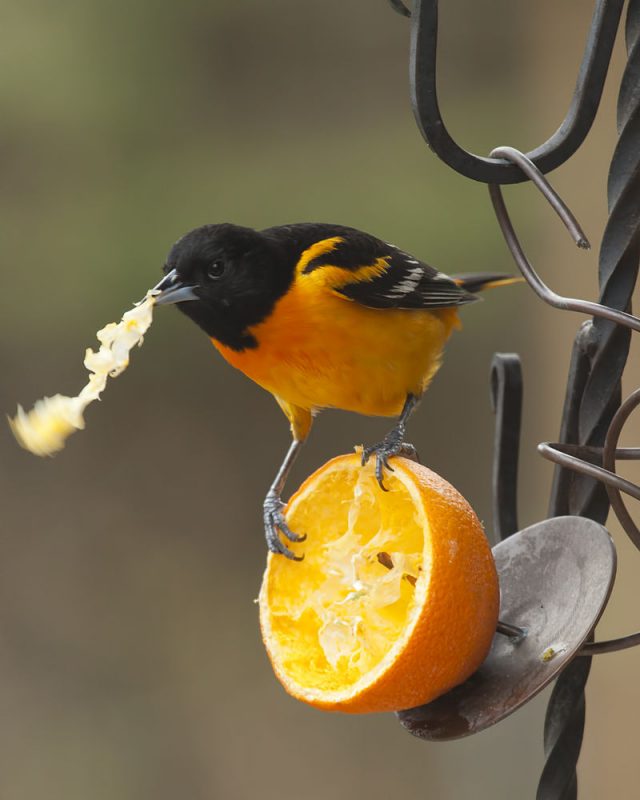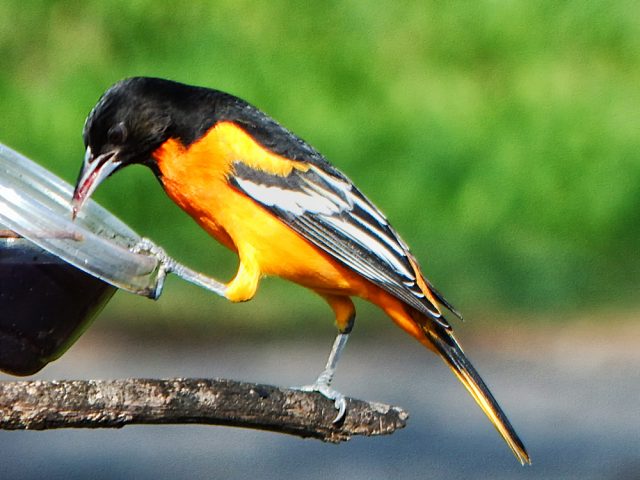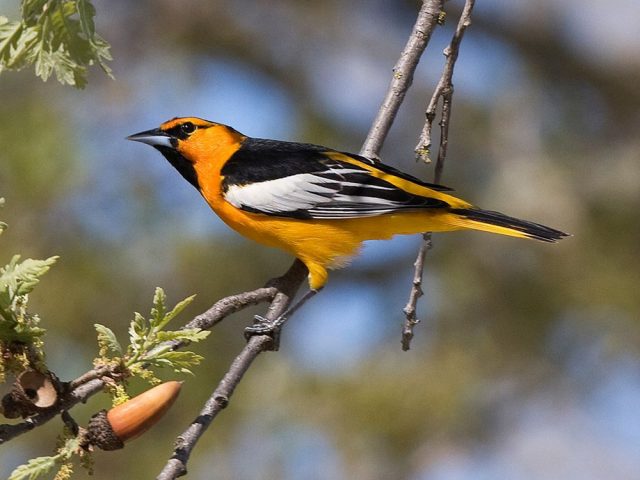9/15/2017 – Oodles of Orioles at Area Feeders (Karen Benson)

Orioles are attracted to the color orange and sliced oranges. This Baltimore Oriole is eating the juicy pulp out of the orange half, but discarding the tough membranes. Wikimedia Commons photo.
Orioles everywhere!
If you have put out any form of sweet treat or fruit for the birds lately, then you probably have seen dozens of bright orange-and-black birds stopping by to check out your offering. These beauties are orioles, most commonly Baltimore Orioles, on their way south for the winter.
Baltimore Orioles start their fall migration from their breeding grounds in the northeastern and north-central parts of the United States in August. By early September, they are moving through the eastern half of Texas.

Baltimore Oriole 1000 01.jpg – This male Baltimore Oriole is enjoying the grape jelly that Linda Vegh of Tuleta offers the birds. These orioles have a brush-edged tongue that helps them slurp up the sweet treat. Linda Vegh photo.
Sometimes these orioles appear to be travelling in flocks. I observed a group of Baltimore Orioles going from a small motte of brush to a live oak this morning. I counted the birds as they flew past, almost in single file. Seventeen! Oberholser in his The Bird-Life of Texas (1974) states that “though not a gregarious species, Baltimores frequently appear in small groups during migration.” Most of the seventeen were males, with their coal-black heads and bright orange bodies, but there were a few females and immatures in the group. I also saw four more females in the same motte a few minutes later. That means this “small group” had at least twenty-one individuals in it!
The best way to attract orioles is to put out orange halves. Some people place the oranges on a platform feeder. You can also nail the halves to a tree trunk, or alternatively, to a board leaning against a tree or fence. There are even special oriole feeders designed to hold cut oranges. The orioles drop by and eat the pulp out of the orange half, neatly leaving an empty rind.

– Bullock’s Oriole is a close cousin to the Baltimore Oriole. Instead of a black hood, Bullock’s have a thin black eyeline and a black throat. Bullock’s Orioles breed in South Texas and can be found all summer, whereas the Baltimores only migrate through. Wikimedia Commons photo.
Oberholser claims the Baltimore Orioles are primarily insectivores. He states that they have a decided preference for caterpillars. But, as they forage in the treetops for insects, they frequently take fruits and even sip nectar from flowers. There is no question that Baltimore Orioles have developed a sweet tooth. They will visit hummingbird feeders to sip the sugar water if they can get their larger bills into the openings. Birdwatchers report that these orioles will pop off the fake flowers on hummingbird feeders to get at the juice. Most oriole feeders are designed with larger openings to accommodate the bigger birds. These same feeders often have special cups to hold grape jelly, another oriole favorite.
Linda Vegh, a birdwatcher in Tuleta, regularly puts out jelly for the orioles. She has found that these birds are a bit picky. They turn up their bills at strawberry jam and orange marmalade. In fact, her orioles are brand-conscious. She claims that they will only eat Bama brand grape jelly! They ignore other brands and even homemade mustang grape jelly! Can you believe it?
You may have noticed that we have a similar oriole here during the summer. This is the Bullock’s Oriole. It is a breeding bird throughout the American West and south into Mexico. Bullock’s Orioles are the western counterparts to the Baltimore Orioles. Both orioles are brilliant orange with some black on the heads, wings and tails. Bullock’s have a black eye line and a black throat while Baltimores have a solid black hood. Bullock’s also have a broad white wingbar whereas the Baltimore’s wingbar is narrow. The females of both species are almost identical. These two species are so similar that there have been cases of interbreeding in areas where their ranges overlap. This fact prompted the American Ornithologists’ Union to “lump” them together as one species, the Northern Oriole, in the AOU Check-list of North American Birds in 1983. However, subsequent research indicated that the two species were actually quite distinct. In the 1998 edition of the Check-list, Baltimore and Bullock’s Orioles were again reinstated as separate species.
Initially, the name oriole applied to a completely different group of birds in the Old World. The word “oriole” is derived from the Latin aureolus, which means “golden.” When New World orioles were discovered, they looked so much like the Old World ones, at least in color, that the name was applied to them too.
Our orioles are just golden- and orange- splashed blackbirds. But, their bright, flame-colored plumage is so appealing, we birdwatchers rejoice at the sight of these visitors to our yards. They are worth all the sugar water you make, all the oranges you slice, and all the grape jelly you buy.
